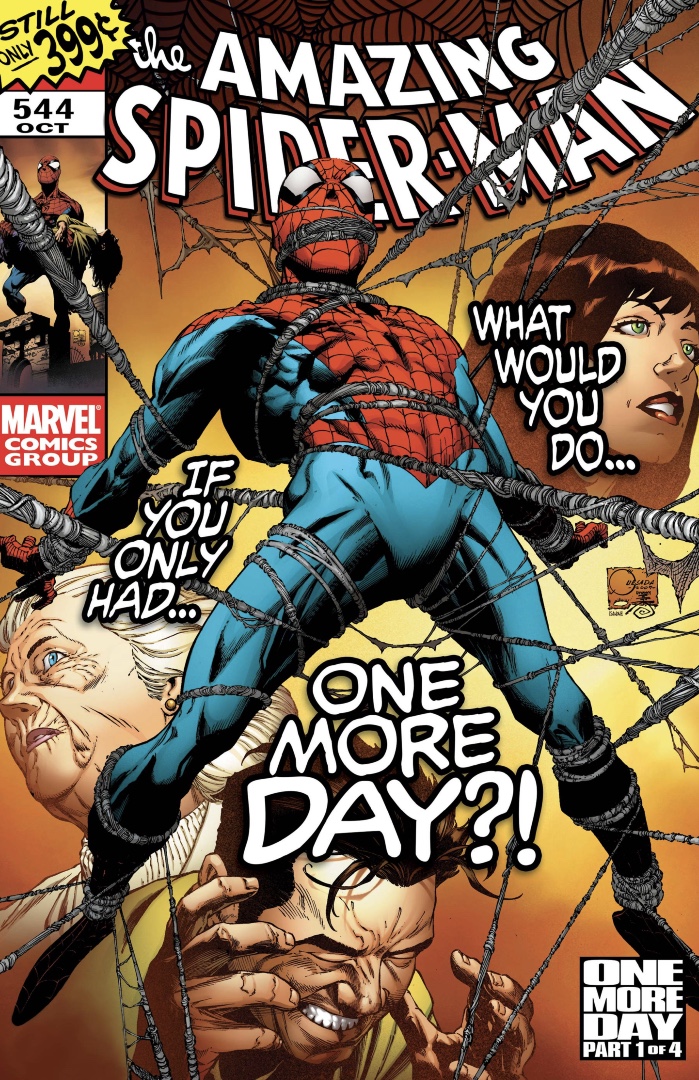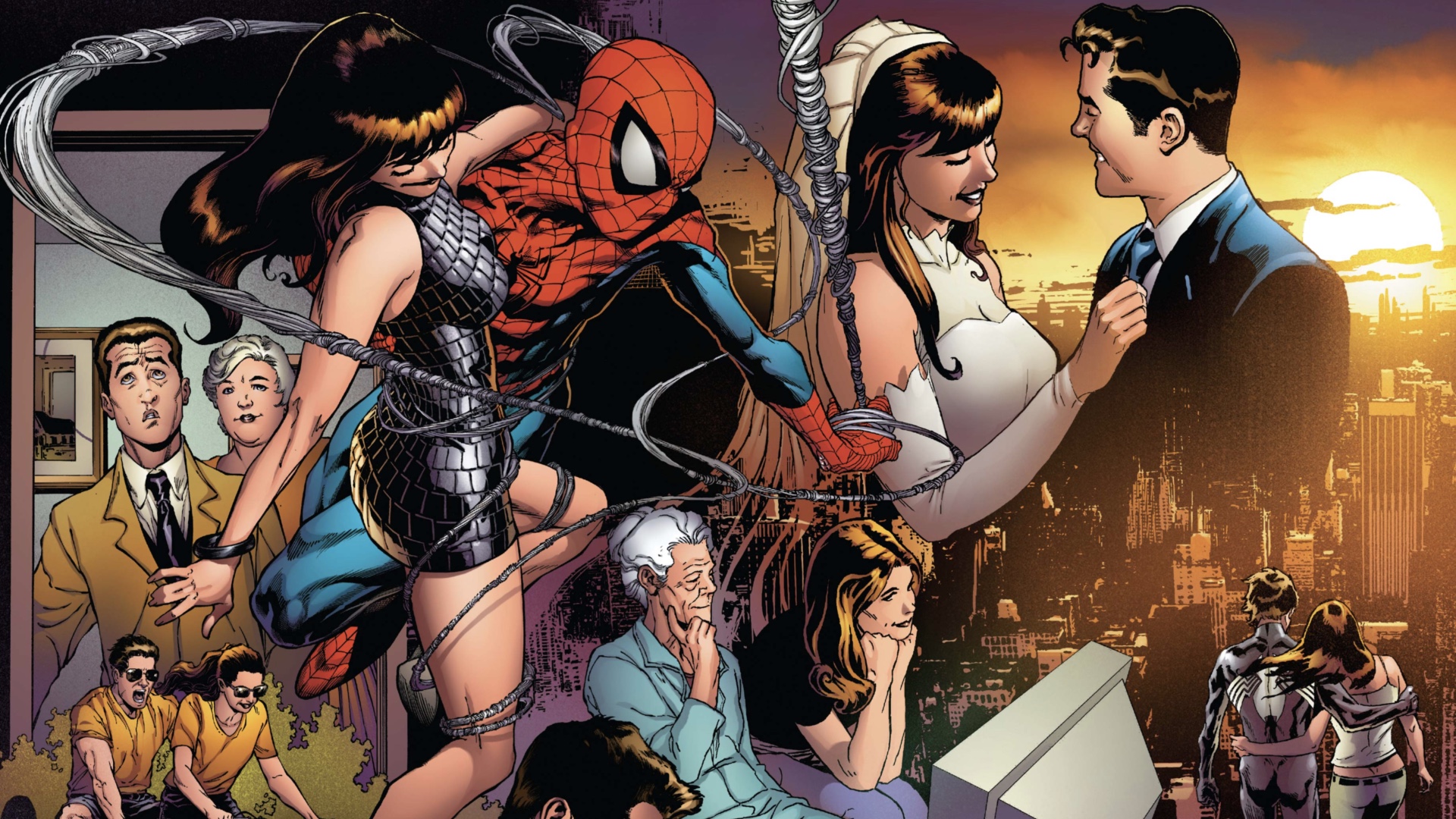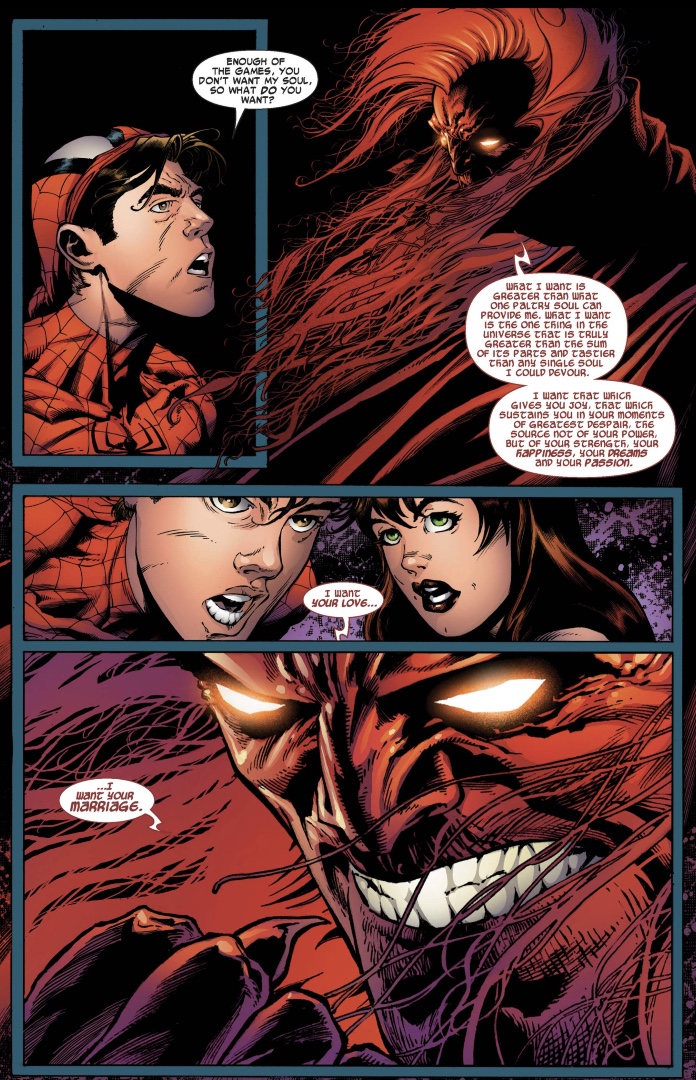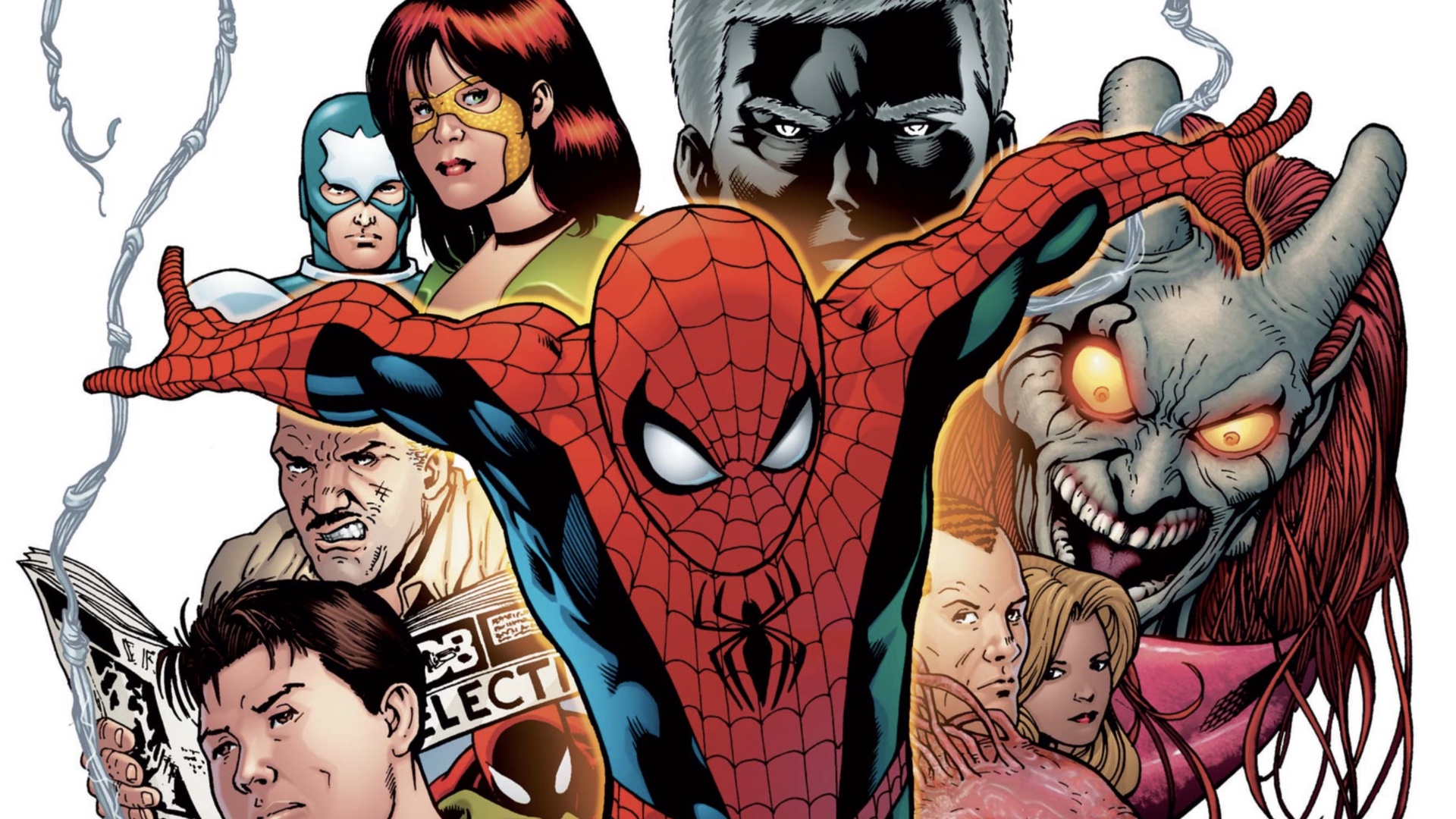Official Spider-Man: No Way Home trailer hints Spidey's most controversial story could reach the MCU
One More Day, one more time? Doctor Strange and magic may be the solution ... again

Spider-Man: No Way Home, the third, perhaps final Spidey-MCU collaboration between Marvel Studios and Columbia Pictures, sets up a predicament for Peter Parker in which the world seemingly knows his secret identity following J. Jonah Jameson publicly airing the reveal in doctored footage by Mysterio at the end of Spider-Man: Far From Home.
Set photos from the filming of No Way Home reveal that Mysterio's revelation has become a hot topic for the public, while promotional art featuring a new costume for Spider-Man shows a growing magical connection between Peter Parker and Doctor Strange, likely tying into the upcoming Doctor Strange in the Multiverse of Madness.

And now, the official teaser trailer for Spider-Man: No Way Home has made the deeper connections between Strange and Spidey official (if not the idea of a magical Spider-suit). What's more, it sets the stage for a solution to Peter's problem that hews closer to one of the most controversial Marvel Comics stories ever than some longtime readers may find themselves comfortable with.
Because while Peter Parker's big problem, his secret life as Spider-Man being exposed, is new for the movie Spidey, it's an issue the hero has gone through and resolved in comic books - and the solution all comes back to Doctor Strange.
In comic books, Peter Parker revealed his identity willingly in the crossover event Civil War (later adapted as Spider-Man's first MCU appearance, Captain America: Civil War) after years of operating in secret, while backing up Tony Stark's Superhuman Registration Act (SHRA). The comic book version of the SHRA, adapted into the MCU's Sokovia Accords, required all superheroes to unmask and register with the government - a stance Peter Parker took after Tony Stark offered him a high paying job and a souped-up Iron Spider suit, a la the one Peter wears in Avengers: Infinity War.
What happened next changed Peter's life - and not just that, it actually led to one of the few instances where Marvel Comics has fully, openly rewritten its past continuity, changing Spider-Man's whole reality in the process - a way of rebooting parts of Spidey's history without fully, openly rebooting its continuity wholesale. The story of Peter's history being rewritten, titled 'One More Day,' has remained one of Marvel Comics' most controversial tales since its publication - not just for Spider-Man, but for the publisher overall.
If the MCU continues down the path it seems to be forging for Spider-Man and his secret identity as Peter Parker, the comic book history of how Pete made his secret identity secret again could spell out massive potential ramifications for what comes next - including the apparent magical apprenticeship between Doctor Strange and Spider-Man.
Get the best comic news, insights, opinions, analysis and more!
How did Spider-Man hide his secret identity in comic books? How was Doctor Strange involved? And how does none other than Mephisto, himself a long-awaited villain for an MCU adaptation, play into the whole saga? We'll explain it all right now.
One More Day

In comic books, Peter Parker kept his secret identity hidden from Spider-Man's friends and foes alike (with notable exceptions) for many years. When his earliest outing as Spider-Man (selfishly trying to earn a payout at a wrestling show) led indirectly to the death of his Uncle Ben, Peter vowed not just to use his power for the greater good from then on, but to keep his identity a secret to protect his loved ones from villains who might attack them to get at Spider-Man.
A few allies, such as the Fantastic Four, Daredevil, and Doctor Strange, were let in on his identity over the years. And of course, his eventual wife Mary Jane Watson learned of his secret life as Spider-Man. By and large, though, Peter hid his true identity even from many of those closest to him, including Uncle Ben's widow Aunt May, Peter's sole caretaker for his first few years as a teen hero.
But when Peter exposes his secret identity to the world in a press conference during Civil War, he opens his family up to the exact type of attacks he always feared would come.
His old enemy Wilson Fisk/Kingpin orders a hit on Peter Parker from behind bars, leading to an assassination attempt in which Aunt May is shot instead of Peter. With May critically wounded, Peter embarks on a brutal quest for vengeance in which he tortures agents of the Kingpin, and finally Fisk himself - betraying the spirit of justice instilled in him by Uncle Ben.
Despite Peter attempting to heal May by giving her a transfusion of his own irradiated blood, May winds up at death's door, with little hope of saving her.
Little hope that is, except for a deal with the devil. This is where the aforementioned 'One More Day' comes in.
Peter is confronted by the devilish Mephisto (who many Marvel fans expected to show up in the MCU streaming show WandaVision), who offers Peter a bargain. Should Peter agree to Mephisto's terms, Aunt May will live, but Peter's past will be rewritten and his marriage to Mary Jane magically dissolved.

Peter eventually agrees to the bargain, and when readers next catch up with Spider-Man and his supporting cast, things are remarkably different, including the key detail of his secret identity now being, well, secret again. (We'll get into what else changed momentarily, along with how Doctor Strange is instrumental to the process).
The story was immediately controversial among fans, critics, and even its own creators. Co-writer and story artist Joe Quesada maintained that the change was necessary for Spider-Man as a character, expressing his opinion that Spider-Man works best when he's struggling with his relationship, occupation, and more, and when his powers are more in line with his original power levels, rather than the added abilities he had evolved in preceding stories, including the introduction of organic webs rather than mechanical web-shooters into comics.
Co-writer J. Michael Straczynski, who had written Amazing Spider-Man for several years leading up to 'One More Day' in a run that vastly redefined Spidey's origins, and even his powers, was open with his distaste for the main aspect of the story which many others also criticized - that being the end of Peter Parker's marriage through magical means rather than dealing with the complex issue of divorce or the end of a marriage through other, more directly relatable means.
"There's a lot that I don't agree with, and I made this very clear to everybody within shouting distance at Marvel, especially [then-editor-in-chief and 'One More Day co-writer] Joe Quesada," Straczynski revealed in a newsletter shortly after the story's publication. "There was a point where I made the decision, and told Joe, that I was going to take my name off the last two issues of the OMD arc. Eventually, Joe talked me out of that decision because at the end of the day, I don't want to sabotage Joe or Marvel, and I have a lot of respect for both of those."
Despite the controversy, the era that followed, dubbed 'Brand New Day,' revitalized Spider-Man as a character and a property, bringing Peter Parker back to his roots while pushing the title Amazing Spider-Man forward in totally new ways - somewhat vindicating Quesada's stance if not his still controversial method of ending Peter Parker and MJ's marriage.
Brand New Day

Following 'One More Day,' the Amazing Spider-Man comic book title underwent a major overhaul. It began publishing three times a month, with a rotating team of writers and artists known as the 'Spidey Braintrust' handling each arc with a different flair.
Interestingly, this model is returning in the upcoming 'Spider-Man Beyond' era, which kicks off in Amazing Spider-Man #75 (more on how 'Spider-Man Beyond' relates to all this in just a moment).
Along with the new publishing status quo, Spider-Man also got something of a fresh start in continuity. Thanks to his deal with Mephisto, Peter Parker's life changed overnight, with the crucial fulcrum of his marriage to Mary Jane now having never occurred at all, though the pair were once a couple in the new, rewritten history.
The elimination of this one key event from Peter's history led to a rippling butterfly effect that changed many events in the lives of Peter, Mary Jane, and the rest of the Marvel Universe which originally followed Peter and MJ's marriage - including the full-on resurrection of Peter's long-dead friend Harry Osborn.
Harry got a new lease on life away from the destruction caused by his descent into becoming the Green Goblin, which had resulted in his death. And likewise, Peter also got a bit of a new lease on life with new villains, new love interests, and his very much alive Aunt May by his side.
And of course, along with Mephisto's rewriting of Peter's past, his secret identity of Spider-Man was once again hidden from the public.
Through the early days of 'Brand New Day,' new aspects of Peter's rewritten history were revealed in nearly every story, though numerous questions about the exact effects of Mephisto's power and how certain events had been undone. Specifically, it was unclear at first how Peter's identity as Spider-Man had become secret again - and why, of all the people who once knew his secret, why Mary Jane was the only person left with the knowledge that Peter Parker is Spider-Man.
Here's where Doctor Strange comes in. And not just Doctor Strange, but Tony Stark, and Reed Richards as well.
Partway through the 'Brand New Day' era, Marvel began teasing an upcoming Spider-Man story titled 'One Moment in Time' (OMIT). Thanks to teasers that resembled wedding invites, and covers that showed Spider-Man and Mary Jane together, some speculated that the story might represent a romantic reunion for the pair and their fan-favorite relationship.

However, the reunion wasn't to be. Instead, 'OMIT' filled in the blanks of the transition from 'One More Day' to 'Brand New Day,' revealing that Mary Jane had convinced Peter Parker to take Mephisto's deal after meeting with the fiend alone and that the one and only moment in Peter's life Mephisto had truly undone was their wedding.
'OMIT' also revealed that following Aunt May's near-assassination - which still happened in Peter's new history, albeit with more favorable results for May - Peter had visited Doctor Strange seeking help to hide his secret identity again.
In the flashback story, Strange consults Reed Richards and Tony Stark, and the three mentors of Peter Parker all agree to help hide Spider-Man's secret while also finding a way to allow him to maintain his own memories of all that transpired.
Strange crafts a spell to make everyone across reality, including himself, Reed, and Tony, forget that Peter Parker is Spider-Man, while also incorporating a warding spell to shield Peter from the effects of the enchantment.
With Strange, Reed, Tony, and Mary Jane present, Peter enters the machine and the spell begins. But at the very last second, Peter pulls MJ into the warding spell with him, preserving her memories of their love - and leaving her the only person who knows his secret identity. The pair return to Peter's apartment, reconcile their separation, and come to terms with the trauma they have endured together. MJ departs, and the story ends around the time 'Brand New Day' began, filling in the missing pieces of Spider-Man's hidden identity and the retcons to his past stories.
But that wasn't really the end of Mary Jane and Peter Parker's relationship, and over the years, subsequent Spider-Man stories have brought them dangerously close together, flirting with the potential effects of somehow undoing Mephisto's bargain.
Now, the will-they-won't-they/can-they-can't-they drama of Peter and MJ's relationship seems to be coming to a head as current Amazing Spider-Man writer Nick Spencer wraps up his run in advance of a new group of creators who will take Amazing Spider-Man to a thrice-monthly release schedule later this year.
The upcoming 'Spider-Man Beyond' era kicks off with Peter Parker leaving the role of Spider-Man to his clone Ben Reilly (that's its own kettle of fish - read about Ben Reilly in Spider-Man Beyond right here), with Doctor Strange currently facing Mephisto in a game of chance for Peter Parker's soul - with Mysterio somehow mixed up in the middle of things.
And likewise, Doctor Strange is about to be taken off the board in the Death of Doctor Strange limited series, setting up both Peter Parker and Doctor Strange to be off the table for an unspecified period of time - likely till Spider-Man's 60th anniversary in 2022, and Strange's in 2023. And of course, it's a safe bet both MCU stars will be back in time to coincide with the hype of the intertwined sequels Spider-Man: No Way Home and Doctor Strange in the Multiverse of Madness.
Spider-Man in the Multiverse of Madness

The official teaser trailer for Spider-Man: No Way Home establishes that following the exposure of his identity in the MCU, Peter Parker turns to Doctor Strange for help in the form of a spell to erase peoples' memories of his identity.
Just like in comic books, Peter interferes with the spell in order to preserve a few peoples' knowledge of his secret - but in the movie, this interrupts and alters the spell, which Strange states has "tampered with the fabric of space-time," and connected them to the wider Multiverse.
As a result, it seems some of Spider-Man's arch-foes from other realities will be returning from across the Multiverse - including the previously revealed Doctor Octopus, played by Spider-Man 2's Alfred Molina, and Jamie Foxx's Electro from Amazing Spider-Man 2. And, as revealed by his signature pumpkin bomb and cackle, it looks like Willem Dafoe's Green Goblin is returning too - perhaps forming the first half of an MCU Sinister Six, alongside Doc Ock and Electro.
There are still big questions about the movie though. For one thing, could Mephisto somehow be involved? He hasn't shown up in the MCU at all yet, though fans have clamored for an appearance starting with speculation he'd be revealed as the villain of WandaVision (which also ties into Doctor Strange in the Multiverse of Madness).
He could be at the heart of the crisis Peter Parker is facing, perhaps even somehow being retroactively involved in Mysterio's machinations in Spider-Man: Far From Home. But there's also the chance that the Dread Dormammu, Strange's nemesis from his first film, could be subbed in as the infernal power behind Strange and Spider-Man coming together.
Though it's not clear whether it's in some way MCU canon or not, the evil magical tome the Darkhold was tied to Dormammu in Agents of SHIELD in one of the show's loose connections to contemporary MCU films of the time. The book resurfaced in WandaVision, with Wanda, who will next appear in Multiverse of Madness, taking possession of it. Even if the Agents of SHIELD connection isn't preserved moving forward, could the Darkhold's TV connection to Dormammu make it to the movies?

One thing that's clear is that however they get there, Marvel Studios and Sony have their own Spider-Man web to untangle, with the film rights to Peter Parker about to be unavailable for the MCU, and Sony building a separate Spider-Man-centric Marvel Universe in its own movies - some of which, like Morbius, have shown potential connections to the MCU.
When Marvel Comics needed to fix what the powers that be felt were issues with Spider-Man that were holding back and complicating his stories, they turned to Mephisto, magic, and Doctor Strange for the solution. Marvel Studios seems to be pushing in a similar direction for the movie Peter Parker, potentially also looping in the concept of Multiverse variants introduced in Loki.
Whatever happens next, Marvel Studios is tying the solution to the MCU Spider-Man's identity crisis into a complex web of plots and subplots which, when unraveled, could spell out big changes for the character on film - hopefully with some less controversy than how things played out on the page.
'One More Day' is one of the most controversial Spider-Man stories ever. On the other hand, here are the best Spider-Man stories of all time.
I've been Newsarama's resident Marvel Comics expert and general comic book historian since 2011. I've also been the on-site reporter at most major comic conventions such as Comic-Con International: San Diego, New York Comic Con, and C2E2. Outside of comic journalism, I am the artist of many weird pictures, and the guitarist of many heavy riffs. (They/Them)



